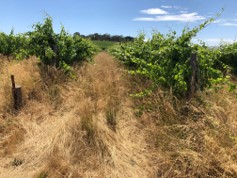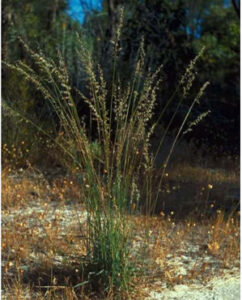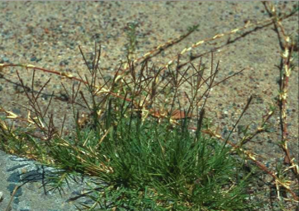Background
Mid-row cover crops (permanent swards and annual cover crops) are commonly used in vineyards to improve soil health and manage weeds in the mid-row. More recently, researchers and growers have been trialling undervine crops as a tool to manage undervine weeds. Undervine crops can be established by either encouraging volunteer plants that are already growing in the vineyard to establish undervine or by sowing a new crop.
Volunteer swards can be established undervine by mowing and side-throwing a mid-row volunteer sward or by simply leaving volunteer plants that are already growing to spread.
Action
As with sown undervine cover crops, actively growing volunteer swards compete with weeds for water and nutrients and also suppress weed seed germination by blocking sunlight from reaching the soil surface.
Volunteer sward residues can also suppress weeds during summer when retained as a surface mulch. Volunteer mid-row sward residues can provide some weed control undervine when mown and thrown undervine.
Advantages and disadvantages
Advantages: A key advantage of volunteer undervine swards compared to sown undervine swards, is the absence of costs associated with the seed and the seeding. Volunteer swards that are already growing well on the site may also be easier to establish undervine compared to a sown crop.
Any plant growth undervine generally has a positive influence on water infiltration. Depending on the species, volunteer swards may also provide additional benefits such as increasing soil carbon levels, stabilising soils and attracting beneficial insects.
Disadvantages: As with sown cover crops, the species of plants that make up the volunteer sward will influence the extent to which the sward competes with vines if not managed effectively.
It may be more difficult to establish a weed-free volunteer sward undervine compared to a sown undervine sward. When establishing a volunteer sward using the ‘mow and throw’ method, weed seeds may also be spread from the mid-row to the undervine area. When establishing a volunteer sward by allowing existing undervine plants to spread, it may be difficult to encourage the desirable plants to spread undervine without also encouraging weeds to spread.
Table 1. Performance of undervine volunteer swards in achieving different outcomes
| Ability to reduce weed competition with vines | Good |
| Soil disturbance caused | Low |
| Suitability in young vineyards | Good (provided highly competitive species are not used) |
| Length of weed control | Good |
| Operating cost | Low |
| Capital cost | Low |
Considerations
As with sown cover crops, the characteristics of plant species within the volunteer sward must be considered before establishing the plants undervine. These include:
- Growth habit – tall growing plants can increase humidity around bunches and disease risk, when allowed to grow into the canopy. Tall growing plants may also increase frost risk in frost prone areas, unless managed appropriately.
- Life cycle – summer-active plants are generally not suited to the undervine area in dryer climates.
- Water and nutrient requirements – some annuals and biennials may continue to grow through summer if supplied with water, increasing their competition with vines.
As with sown cover crops, the following factors should also be considered before establishing a volunteer sward undervine:
- Annual rainfall and irrigation availability
- Soil type (sandier soils might benefit from enhance water holding capacity and nutrient storage)
- Availability of equipment for managing the growth of the volunteer sward undervine if required (e.g. undervine mower, whipper snipper, sheep, etc.)
- The risk of fire and/or frost.
Table 2. Ease of establishing undervine volunteer swards on different soil types
| Large or excessive stones | Moderate |
| Stone/gravel | Easy |
| Sand | Easy |
| Silt/loam | Easy |
| Clay | Easy |
Volunteer undervine sward tips
- Good weed control prior to establishing the volunteer sward undervine is essential for good crop establishment. Weed control should be conducted as close as possible to the time that side throwing seed from the mid-row is carried out, to give the crop a chance to establish before the weeds start to grow again. Undervine cultivation provides good weed control in situations where herbicides cannot be used. Weeds that start to grow in the undervine area before the crop has germinated can be managed by mowing.
- To influence the species composition of volunteer undervine swards, establish a desirable sward in the mid-row in season one, and then mow and side throw the mid-row sward after seed set in season two.
- Mow or cultivate the volunteer sward before bud burst in frost-prone areas or leave it to ‘hay off’ if frost risk is low, soil moisture is adequate and crop growth does not reach the canopy. Mowing reduces soil disturbance and preserves soil organic carbon levels. Undervine sweeping can be used to pull the crop away from the canopy without disturbing the soil.
- Where possible, delay mowing until after the volunteer sward has flowered and set seed to encourage regeneration, especially with annual species.
- Re-throw the mid row annually if volunteer sward establishment is sparse – good sward establishment will improve weed suppression.
- After mowing, leave clippings undervine to provide a mulch. The most persistent mulch will be provided when stem material has lignified prior to mowing.
Growers’ experiences
In McLaren Vale, SA, where the climate is Mediterranean and the average annual rainfall is 506 mm, Gemtree recognises the benefit of growing crops undervine to suppress problem weeds such as couch and kikuyu.
In one of its sandier sites, Gemtree noticed that the perennial veldt grass that was growing naturally in the mid-row area of the vineyard was starting to outcompete the couch weeds. Rather than try to sow a cover crop undervine, they decided to encourage the veldt grass to establish undervine by slashing and side throwing the mid-row after the veldt grass had flowered and set seed. To make sure that mowing and throwing were not going to spread viable couch seed undervine along with the veldt grass, Gemtree developed a strategic mowing and throwing tactic based on the differences in the growth habit and lifecycle of the couch and veldt grass (Figure 1).

Figure 1. Volunteer perennial veldt grass suppressing couch grass in the mid row and undervine area of a vineyard in McLaren Vale (photo courtesy of Gemtree)
Perennial veldt grass is an erect, tufted perennial grass, while couch is a spreading, mat forming, wiry stemmed perennial grass. Perennial veldt grass sets a large number of seeds with seed heads extending well above the leaves and up to 80 cm tall (Figure 2). Couch seed heads also extend well above the leaves, but only up to 30 cm tall (Figure 3). Perennial veldt grass grows in winter and grows rapidly after spring, summer and autumn rains, often becoming dormant and dying back during the dry summer months. In contrast, couch is very drought-tolerant and grows actively all year round. In South Australia, couch grass can also flower all year round but viable seed appears to come from late summer to early autumn flowers. Perennial veldt grass mainly flowers from October to November.
Gemtree mows and throws the mid-row towards the end of November, after the veldt grass has set seed. The mower height is set above 30 cm to avoid harvesting any mature couch seed heads.

Figure 2. Perennial veldt grass (photo courtesy of HerbiGuide)

Figure 3. Couch grass (photo courtesy of HerbiGuide)
Resources
Cover crops and weed suppression. (Wine Australia fact sheet).
HerbiGuide. 2014. Weeds. Available from: http://www.herbiguide.com.au/InformationWeeds.aspx
Contact
For further information, please contact:
AWRI helpdesk
Phone 08 8313 6600 Email helpdesk@awri.com.au

